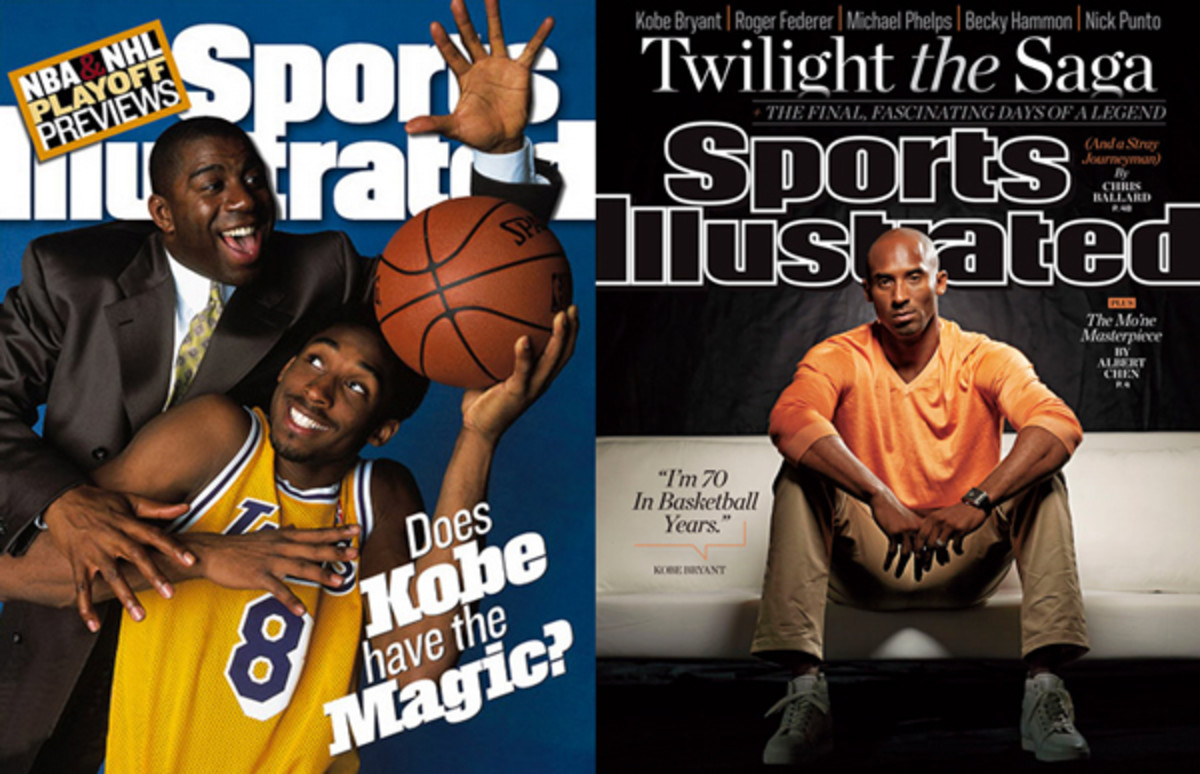Trends: Comparing Kobe Bryant and Michael Jordan as scoring legends

The last time the top three spots of the NBA’s all-time scoring list saw movement was Jan. 22, 2003, when Michael Jordan – a few weeks shy of his 40th birthday – buried a jumper against the New Orleans Hornets to move past Wilt Chamberlain.
Clearly, a lot has happened in the 11+ years since Jordan’s history-making jumper, even as “1. Kareem Abdul-Jabbar (38,387), 2. Karl Malone (36,928), 3. Michael Jordan (32,292)” has remained unchanged in the record books. The six-time champion retired (again), parted ways with the Wizards, purchased a team in Charlotte, and later reclaimed the “Hornets” nickname from the New Orleans franchise. Jordan also turned 50 last year, an occasion that turned the 2013 All-Star Weekend into a tribute to his legacy, with a generation of superstars testifying to his impact.
No one from that group has emulated Jordan’s game, style, influence and accomplishments as well as Lakers guard Kobe Bryant. Back during that 2002-03 season, a 24-year-old Bryant led the league in total points, pumping in 30 a night with a three-peat already to his name. Two more titles and a decade’s worth of All-Star and All-NBA selections later, Bryant has the opportunity to move past Jordan into the No. 3 spot if he scores 31 or more points against the Spurs on Friday. If that doesn’t happen, Bryant’s next chance will come in Minnesota on Sunday. Either way, it’s highly unlikely that Jordan’s spot on the scoring chart survives the weekend.
When Jordan passed Chamberlain in 2003, his reaction embodied the unique drive that he and Bryant share.
“Stats define you when you're 10 or 20 years past the game,” Jordan told reporters. “While you are playing, what matters is wins.”
Think Kobe Bryant shoots too much? The numbers strongly agree with you
Now, with 10-plus years of perspective, the stats and wins continue to define Jordan as the consensus pick for "Greatest of All Time" honors. But Bryant’s impending move up the scoring chart should be viewed as a career-defining accomplishment, a lasting testament to his skill, technique, athleticism, creativity, durability, longevity and will. The milestone should be even sweeter for Bryant and his fans, as the anticipation has built up for more than a year due to Achilles tendon and knee injuries.
How exactly has Bryant managed to scale Mount Jordan? How will stats help define these two players for future generations? How long until the top of the scoring chart next sees movement? Let’s take a look. (Thanks to Basketball-Reference.com.)
Scoring through the years
Pitching the Bryant/Jordan scoring race as "tortoise vs. hare" would be going too far, but Bryant will ultimately pass Jordan because he has been steadier for a longer period of time.
In fact, Jordan's career scoring total -- as big as it is -- really undersells his ability as a point-producer. The major reason for that is obvious: Jordan retired twice during the middle of his career, costing himself nearly two full seasons of his prime by playing baseball following Chicago's first three-peat and another few years of accumulation time after Chicago completed its second three-peat. Had Jordan played straight through from 1984 until his third and final retirement in 2003, there's a very good chance that he would be the only player in NBA history to score 40,000+ points.
It wasn't just the multiple retirements that limited Jordan's final total. He missed the majority of the 1985-86 campaign, his second season, with a foot injury. That injury cost him somewhere in the neighborhood of 2,000 points. An even bigger issue, especially in comparison to Bryant, was Jordan's decision to play three years of college basketball at North Carolina. Bryant, of course, went the preps-to-pros route, which gave him a multi-year head start on Jordan. Although Bryant wasn't necessarily a go-to player in his first few seasons, he had still accumulated 2,755 points prior to his age-21 season, the same age that Jordan began his professional career with the Bulls.
• Play FanNation's new NBA games:Fast Break | BasketballThrowdown
The following is a chart that shows Bryant and Jordan's scoring totals year by year, based on their age. The chart makes it easy to see Bryant's head start, his general steadiness through his career, and the flat-lining impact of Jordan's mid-career retirements.
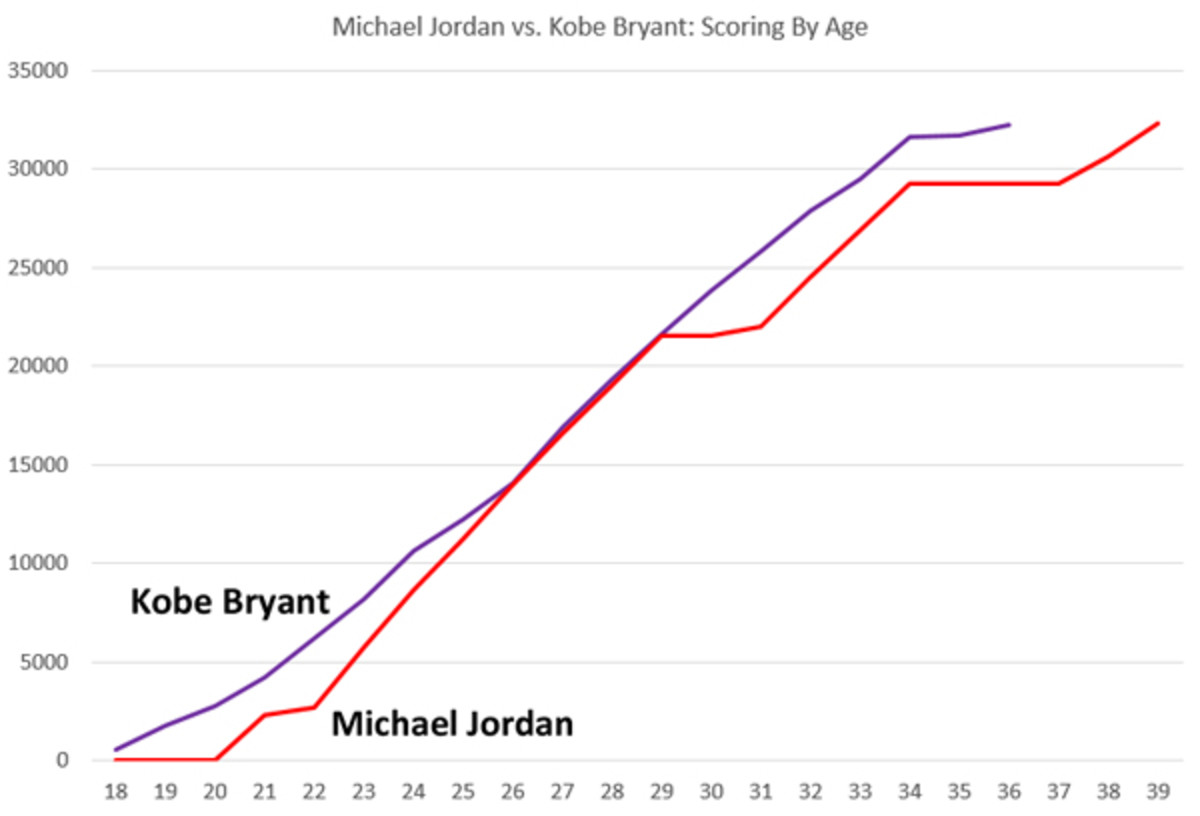
(Click for larger version)
Perhaps the most striking aspect of that chart, however, is just how close the two players were in their career scoring totals throughout their late-20s. Bryant and Jordan get compared for all sorts of reasons: their rings, their relationships with coach Phil Jackson, their demanding and aggressive treatment of teammates, and even their body language and mannerisms. But look at how their scoring lines, from age 26 through age 29, are virtually identical. It doesn't get any closer than that. Really, it's pretty spooky.
That chart also illustrates Jordan's role as the "hare." Especially during his early-to-mid 20s, Jordan was accumulating points at a much faster pace than Bryant, who was sharing scoring duties with Shaquille O'Neal at that point of his career.
Although Jordan's 10-2 advantage in scoring titles pretty clearly reflects his advantage as a volume scorer, the following chart compares Bryant and Jordan based on scoring average throughout their respective careers.
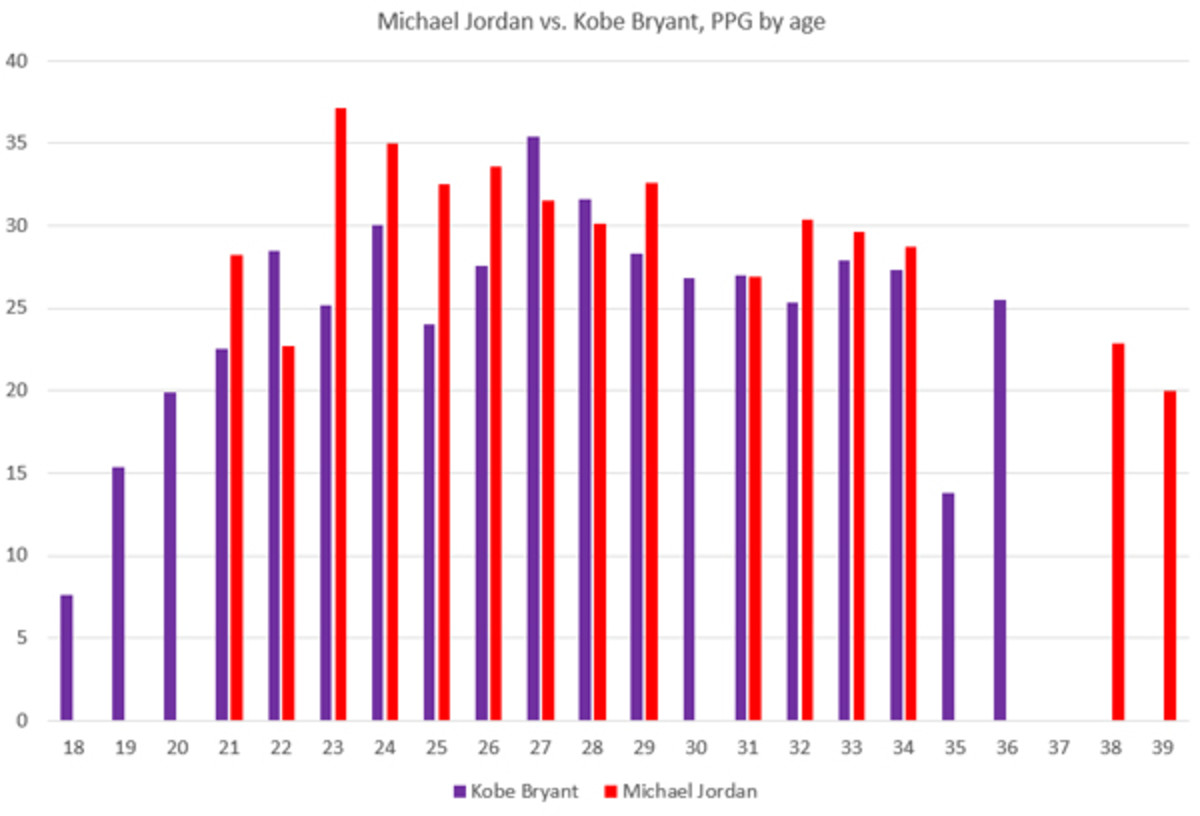
(Click for larger version)
Bryant and Jordan spent a total of 13 age-similar seasons in the league. (For example, Jordan and Bryant both had age-21 seasons, but Jordan didn't have an age-30 season because he was playing baseball.) Jordan enjoyed a higher points per game average than Bryant in nine of those seasons. Plus, two of the four seasons that Bryant outscored Jordan were age-22 (when Jordan had a broken foot for most of the year) and age-31 (when Jordan came back midseason following his first retirement). One final feather in Jordan's cap: his highest scoring average was 37.1 points per game in 1986-87, while Bryant's highest average was 35.4 points per game in 2005-06. There's really no question here: Jordan was more lethal.
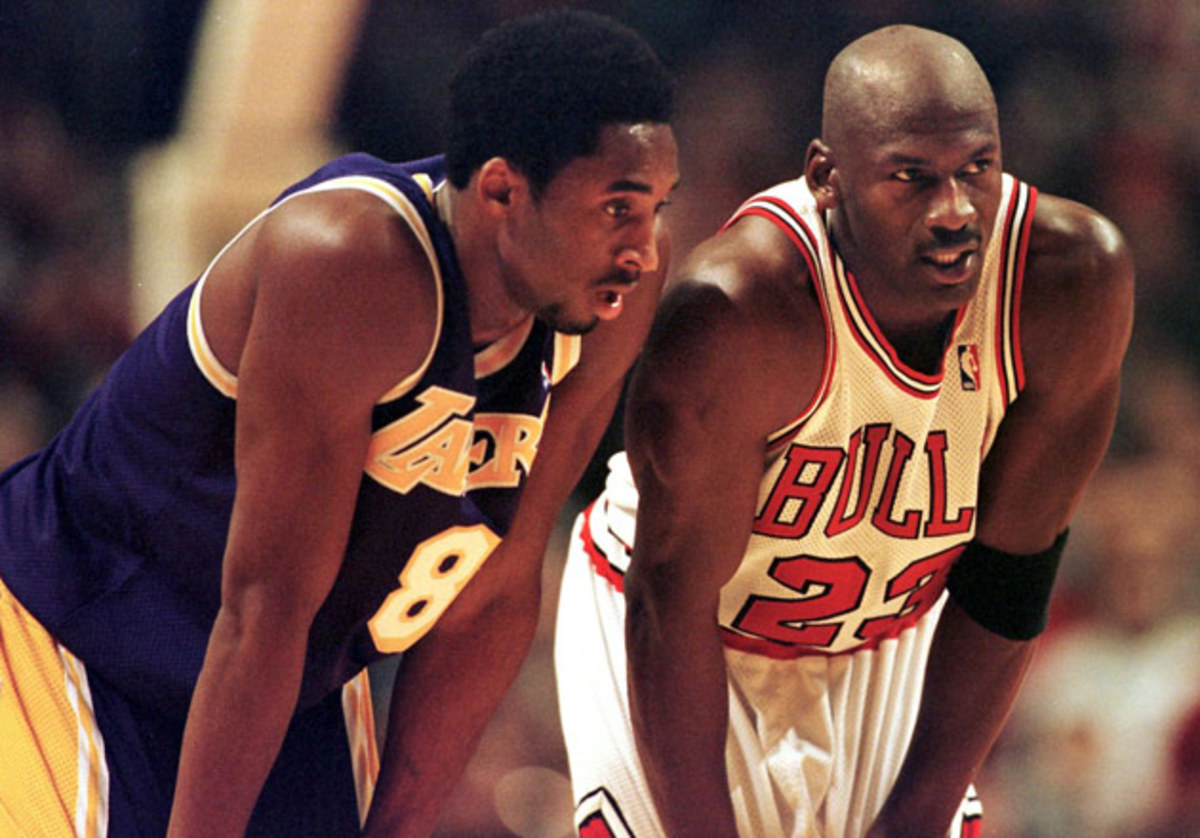
Scoring by type
One fascinating point of contrast these two scoring greats is their reliance on the three-pointer. Neither player will be remembered as a long-distance threat: Jordan was a career 32.7 percent three-point shooter while Bryant is a touch better at 33.4 percent. Last season, the league average was 36 percent.
Although Jordan's three-point attempts spiked quite a bit during Chicago's title years -- topping out at 3.6 attempts per game in 1996-97 -- he essentially ignored the longball for his first five seasons and he rarely shot from outside when he came back with the Wizards. He could beat defenses in so many other ways -- from mid-range, in transition, from the post, at the foul line, etc. -- that the arc didn't really have that much to offer him. Of course, he was also playing in line with the trend of his time, as far more three-pointers are hoisted in the modern game than were during the 1980s.
Second annual All-Atrocious Team: The worst starters in the NBA
Some might assume that Bryant's shot distribution mirrors Jordan's, but that's not the case at all. Bryant averaged a career-high 6.5 three-point attempts per game in 2005-06 (nearly double Jordan's career-high) and he averaged at least four three-pointers per game in 11 different seasons. The end result? Bryant has made nearly three times as many career three-pointers as Jordan.
The following pie charts show how Bryant and Jordan have accrued their points, whether it was by making a two-point shot, a three-point shot or a free throw. Note that they have very similar performances from the free-throw line, but that Bryant's "three-pointers" slice is significantly larger than Jordan's.
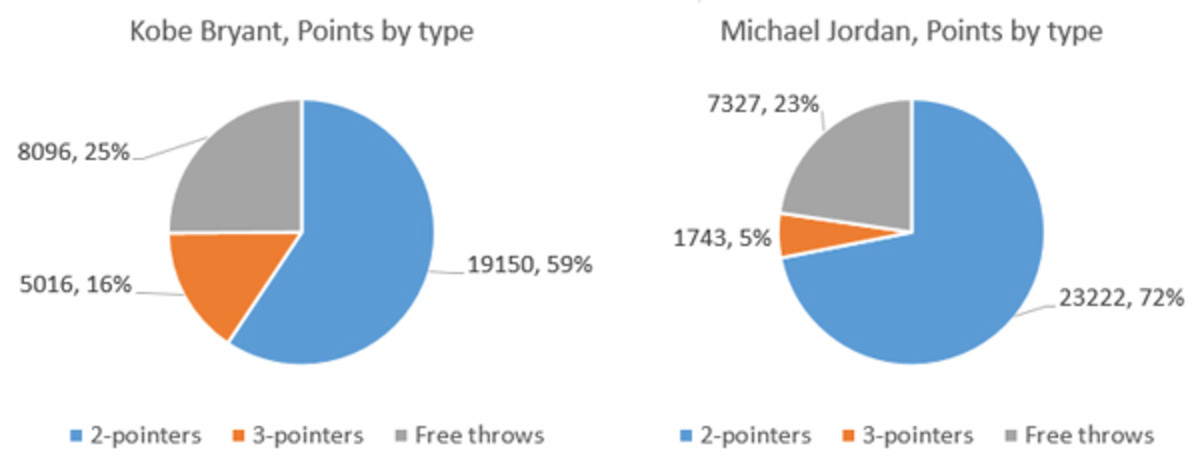
(Click for larger version)
Scoring by efficiency
One area in which there really is no comparing Jordan and Bryant is scoring efficiency. That probably doesn't come as a surprise, what with Bryant taking heat throughout his career for his shot selection, alleged unwillingness to move the ball, and the fact that he recently made headlines by becoming the NBA's all-time leader in missed field goals.
Importantly, though, there's really no shame in finishing behind Jordan in shooting efficiency. He was just that good. During Jordan's 13 years in Chicago, he shot 50.5 percent from the field (better than all 30 NBA teams in 2013-14) and he posted a true shooting percentage of 58 (better than every team except the Heat in 2013-14). Bryant's career 45.2 percent shooting would have ranked 14th among the 30 NBA teams last season, while his 55.4 true shooting percentage would have been tied for ninth.
Turning again to the 13 age-similar seasons shared by Jordan and Bryant, Jordan posted a higher field goal percentage in 11 of them. The only two exceptions? The year he broke his foot (1985-86) and his first partial season back after his baseball retirement (1994-95). However, Jordan's edge narrows to 8-5 when it comes to true shooting percentage due to Bryant's heavier reliance upon the three-pointer. Again, two of Bryant's five seasons with a better true shooting percentage are 1985-86 and 1994-95.
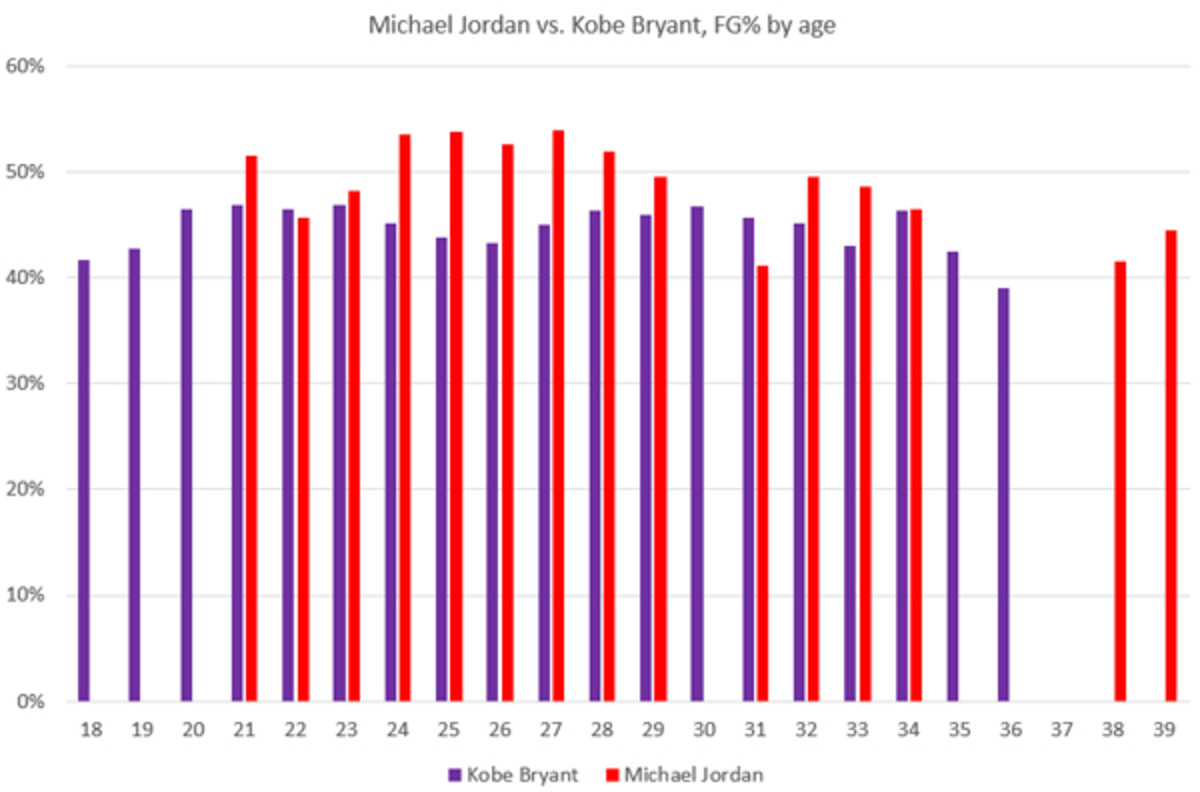
(Click for larger version)
This story remains the same when the subject turns to Player Efficiency Rating or Offensive Rating. As the charts below show, Jordan enjoyed a better PER in all 13 of their age-similar seasons and a better offensive rating in 11 of their age-similar seasons (again, 1985-86 and 1994-95 are the only exceptions). Jordan's best PER (31.7 in 1987-88) was significantly better than Bryant's best (26.2 in 2002-03); Jordan also led the league in PER seven times to Bryant's zero. Jordan's top offensive rating (125 in 1990-91) was also much better than Bryant's best (115 in 2006-07).
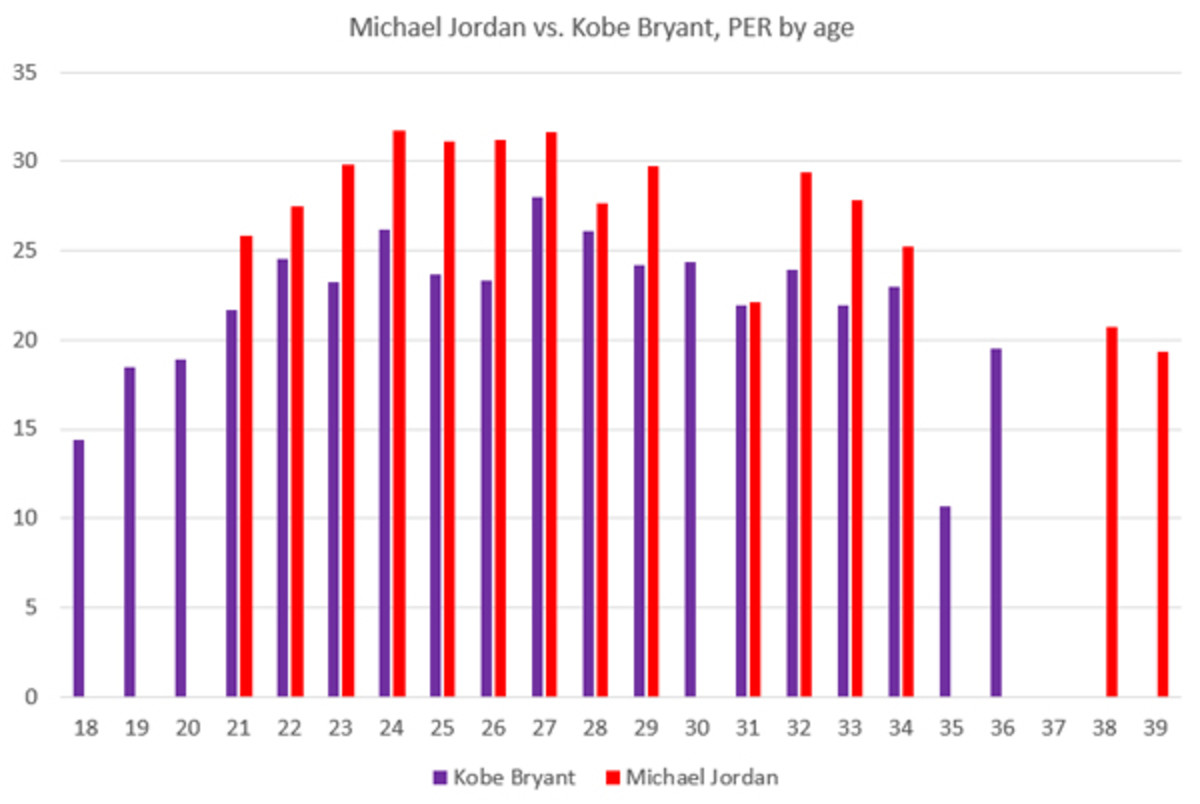
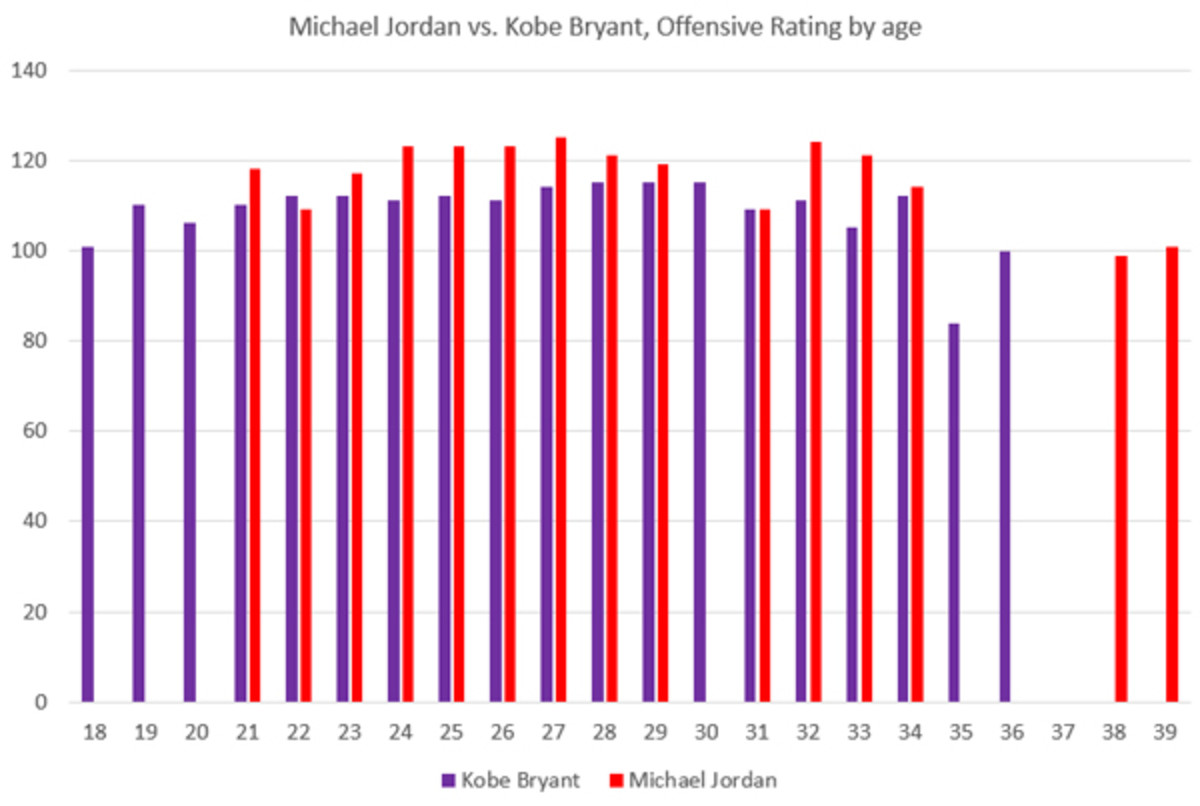
(Click here and here for larger versions)
Scoring in volume
By now, many Bryant diehards might be yawning or dismissing Jordan's clear advantage when it comes to scoring precision. Their oft-used counter-argument: 81.
Even though one magical night obviously shouldn't outweigh a decade-plus of ruthlessly efficient scoring, Bryant's 81-point effort against the Raptors on Jan. 22, 2006, rightfully possesses a special place in basketball history. That's the second-highest individual point total of all time. That's the highest individual point total in the modern era, as Chamberlain's record-setting 100-point night came in 1962. That's a full 12 points more than Jordan ever scored in a game (Jordan needed overtime to score a career-best 69 points against the Cavaliers on March 28, 1990).
Was Bryant or Jordan the better volume scorer? There are arguments to be made both ways. The chart below shows that Jordan tallied far more 50+ point games but that Bryant, in addition to his unmatched 81-point night, also enjoys the edge in 60+ point games.

One other interesting factoid in Bryant's favor: the Lakers are 5-0 when he scores at least 60 points, while the Bulls were 2-2 when Jordan hit that threshold.
Scoring head-to-head
Although they entered the league 12 years apart, Bryant and Jordan did play head-to-head on eight occasions, beginning in Dec. 1996 (Bryant's rookie year) and ending in March 2003 (Jordan's final season).
Bryant holds a 5-3 advantage in those contests: Jordan's Bulls were 2-2 against Bryant's Lakers, while Jordan's Wizards were 1-3. Bryant also scored 55 points on Jordan's Wizards in their final head-to-head meeting, while the most Jordan managed against Bryant's teams was 36 points on Dec. 17, 1997.
Their individual numbers in head-to-head match-ups were very similar despite their age difference.
- Jordan vs. Bryant: 24.5 PPG, 4.3 RPG, 3.6 APG, 43.6 FG%
- Bryant vs. Jordan: 22.8 PPG, 4.4 RPG, 3.9 APG, 46.6 FG%
Although they never met in the playoffs, Bryant and Jordan did square off in three All-Star Games. Their 1998 duel -- Jordan won MVP honors with a game-high 23 points, while Bryant led the West with 18 points -- was particularly memorable.
Scoring in the playoffs
Jordan fans who are feeling down about Bryant's movement up the all-time scoring chart would do well to focus their attention on MJ's unmatched scoring ability in the playoffs.
A perfect 6-0 Finals record, with no Game 7s needed, is a tidy, oft-cited way to sum up Jordan's postseason dominance, but his postseason point total and scoring average don't get nearly enough attention.
Open Floor: Bucks booming after big makeover, Knicks' debacle and more
In 179 total games over 13 trips to the playoffs, Jordan scored an NBA-record 5,987 postseason points and averaged an NBA-record 33.4 points per postseason game. Bryant, by comparison, ranks No. 3 in total postseason points (5,640), trailing Abdul-Jabbar (5,762). He also ranks No. 10 with 25.6 postseason points per game (Sixers great Allen Iverson is second at 29.7). Given the Lakers' current state, it seems unlikely that Bryant will get the opportunity to log enough postseason minutes to close his 347-point gap on Jordan. In reality, it's possible that Bryant never sniffs the postseason again.
Jordan's 33.4 points per game in the playoffs is a record that should stand for a very, very long time. That level of sustained brilliance when it matters should be referenced as often as Chamberlain averaging 50.4 points per game in 1961-62 or Oscar Robertson averaging a triple-double that same year, given how far ahead Jordan is compared to the rest of the pack.
Scoring in the future
As Bryant knows, records are made to be broken. Once he supplants Jordan at No. 3 on the all-time scoring list, Bryant's own clock will begin ticking. With a gap of nearly 5,000 points separating him from Malone, Bryant will retire in third place if he calls it quits following the 2015-16 season as expected. There are already two perennial All-Stars gunning for Bryant's spot: LeBron James and Kevin Durant.
The age-similar chart below compares the scoring totals posted by Jordan, Bryant, James and Durant. Note: this chart does not include any scoring done during the 2014-15 season.
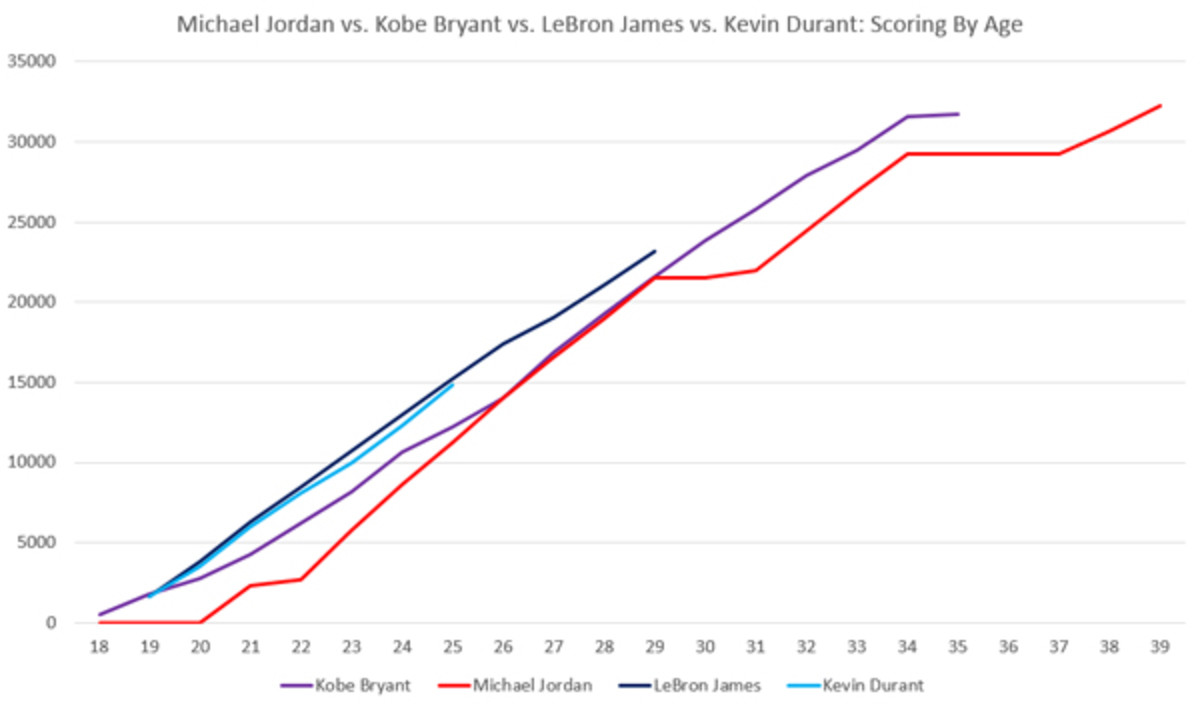
(Click for larger version)
Both James and Durant are off to hot starts when it comes to catching Jordan and, potentially, Bryant on the all-time scoring list. Like Bryant, James enjoys the benefit of having jumped from high school to the pros. Durant also enjoys a two-year head start on Jordan because he spent just one season at Texas. Unlike Bryant, whose early-career scoring came along gradually, both James and Durant were high-volume scorers immediately upon entering the league, putting them on a faster track. Both James and Durant have also avoided serious injury absence, although Durant did experience a slight hiccup this season when he missed more than a month due to a foot injury.
Bryant's own recent injuries served as a reminder that there are simply too many variables to confidently forecast a player's career points total years in advance. The takeaway, for now, is that both James (currently No. 24 all-time with 23,665 points) and Durant (currently No. 131 all-time with 14,958) will be in position to supplant some major names on the all-time scoring charts if they continue to enjoy good health and decide to play deep into their thirties.
What are their odds? Using Bill James' straightforward projection tool to determine a rough estimate, James has a 97 percent chance of passing Jordan and a 41 percent chance of moving past Abdul-Jabbar. Durant, meanwhile, currently has a 69 percent chance of passing Jordan and a 38 percent chance of passing Abdul-Jabbar.
Total accomplishments
What's the point of an extended Bryant/Jordan comparison if all angles aren't considered? Below, find a table comparing these two greats in all sorts of different categories.
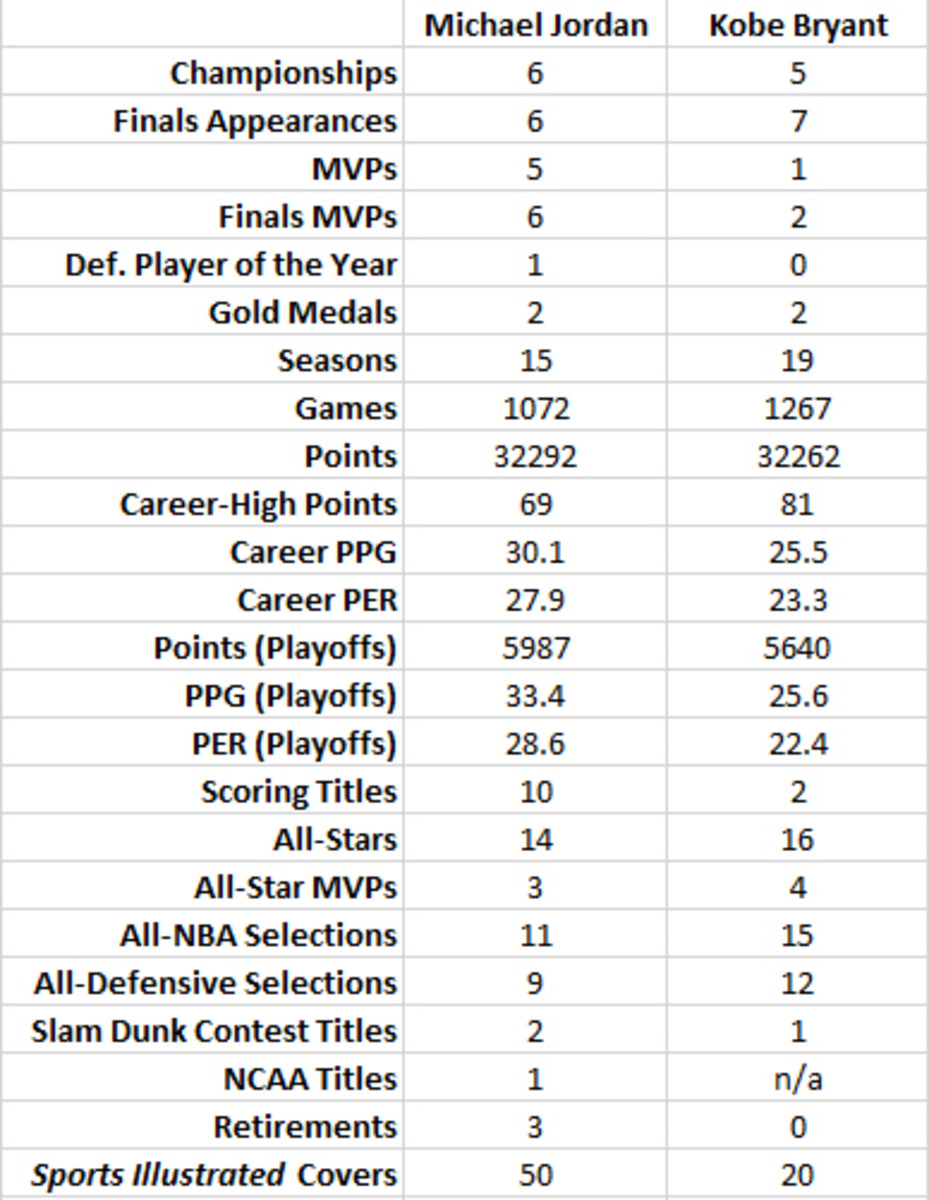
Sports Illustrated covers
There is at least one category in which Bryant will never pass Jordan: Sports Illustrated covers. Jordan has been featured on the cover a record 50 times; Bryant, on the other hand, has been the cover boy on a measly 20 occasions. (For comparison's sake, James has already graced the cover 23 times.)
Jordan first appeared on the Nov. 26, 1983, cover when he was a junior at UNC. He was featured alongside teammate Sam Perkins for the college basketball preview issue. His most recent cover: the Feb. 18, 2013, issue which celebrated his 50th birthday.
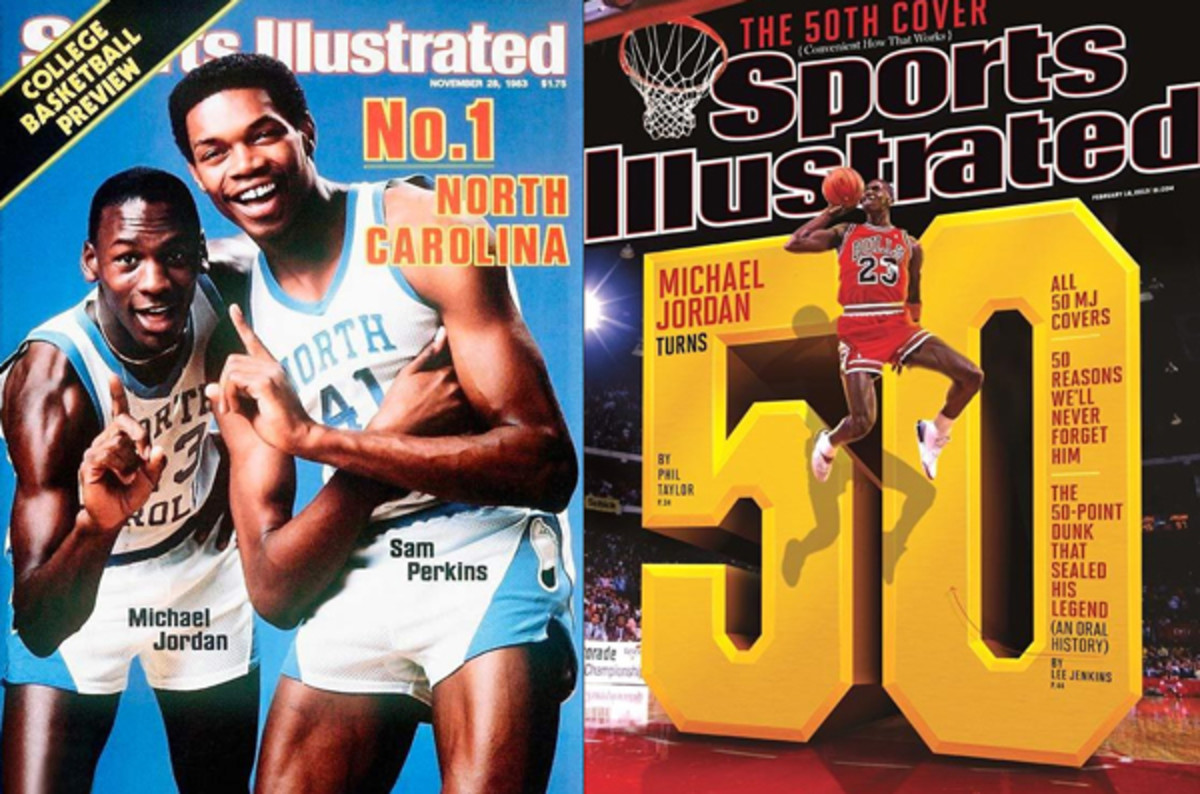
Bryant's first cover came on April 27, 1998, during his second NBA season. He appeared alongside Lakers legend Magic Johnson on the NBA playoffs preview issue. His most recent cover: the Aug. 25, 2014, issue which bore a "Twilight the Saga" headline.
